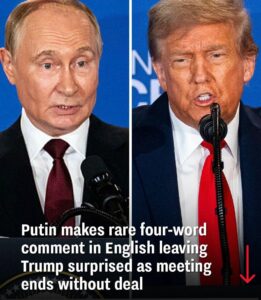Putin Stuns Trump With Rare English Remark as Alaska Summit Ends Without Deal

A long-awaited meeting between two of the world’s most powerful leaders wrapped up without the breakthrough many were expecting, yet it offered rare glimpses into the personal dynamics shaping today’s most pressing geopolitical crisis.
Presidents Donald Trump and Vladimir Putin came face-to-face for the first time since Trump’s return to the White House. Their discussions, held on American soil, carried stakes that reached well beyond Washington and Moscow, touching on alliances, conflicts, and the future of global order.
Despite spending over three hours locked in talks—described by both sides as “constructive” and “productive”—the summit closed without a formal agreement. But it was not the absence of a deal that made headlines. Instead, it was an unexpected personal exchange that left Trump visibly caught off guard and revealed just how delicate the U.S.–Russia relationship remains.
Alaska: A Stage of Symbolism and Strategy
The decision to host the summit in Anchorage, Alaska, was anything but random. Alaska sits fewer than 90 kilometers from Russia across the Bering Strait, making it both geographically practical and symbolically loaded.
The setting at Joint Base Elmendorf-Richardson reinforced the moment’s drama. As the two leaders arrived, American F-35 jets and B-2 bombers performed a high-profile flyover. It was a theatrical reminder of U.S. military power—particularly pointed given that B-2 bombers had recently carried out operational strikes.
Former U.S. Ambassador to Russia John Sullivan called it “extraordinary stagecraft,” contrasting the spectacle with the more understated protocol of past bilateral meetings. The Kremlin, meanwhile, had downplayed the theatrics, with Putin’s aide Yuri Ushakov calling Alaska a “logical” location for such high-stakes diplomacy.
A Build-Up of Tension and Expectation
The Alaska encounter was the culmination of months of diplomatic maneuvering. Trump, who had promised on the campaign trail to end the Russia–Ukraine war swiftly—“preferably on Day One”—had been pushing for a ceasefire through a series of escalating deadlines.
A surprise phone call in February 2024 rekindled dialogue between Trump and Putin for the first time since 2022. This was followed by U.S. Secretary of State Marco Rubio’s meeting with Russian Foreign Minister Sergey Lavrov in Saudi Arabia, before Trump ultimately opted to pursue direct talks in Alaska.
Inside the Negotiations
Trump entered the summit flanked by Rubio, special envoy Steve Witkoff, and key aides. Putin’s side included Lavrov, Defense Minister Andrey Belousov, and Finance Minister Anton Siluanov, signaling the broad scope of topics under discussion—security, arms control, and even economic cooperation.
While Trump told reporters afterward that “many points were agreed to” and only one “significant” issue remained unresolved, neither side disclosed specifics. Putin called the talks “thorough” and emphasized they had taken place in a “constructive atmosphere of mutual respect.”
The Moment That Stole the Spotlight
As the press conference wound down, Putin set aside his translator and addressed Trump directly in English: “Next time in Moscow.”
The comment was brief, but its impact immediate. No U.S. president has set foot in Russia since Barack Obama attended the G20 Summit in 2013, and the idea alone carried heavy political weight.
Trump, visibly taken aback, quipped: “That’s an interesting one. I’ll get a little heat on that. But I could see it possibly happening.” Later, on Fox News with Sean Hannity, he rated the summit “10 out of 10” in terms of personal rapport with Putin—though critics were quick to question whether friendliness equated to progress.
Ukraine’s Stance: No Land for Peace
Perhaps the thorniest issue was Ukraine itself. Trump suggested before the meeting that a peace deal might involve “swapping of territories,” drawing an immediate rebuke from President Volodymyr Zelensky.
In a video message, Zelensky reaffirmed that Ukraine “will not give their land to the occupier” and warned that “any decisions without Ukraine are decisions against peace.”
Reports indicated that Putin sought to formalize Russian control over Donetsk and Luhansk, while holding onto positions in Zaporizhia and Kherson. Kyiv dismissed the idea, insisting that concessions could only be considered after a full ceasefire.
Beyond the Alaska Stage
While the summit ended without concrete deliverables, it underscored how central Trump has positioned himself in negotiations. Both Putin and Zelensky, according to Trump, want him present at future trilateral talks. That mediator role marks a dramatic shift in U.S. posture.
Still, Trump admitted solving the conflict had proven far harder than he once believed. “I thought this would be the easiest of them all,” he told Hannity. “Turns out it’s the most difficult.”
Critics argue that Putin may be stringing Trump along, prolonging negotiations while consolidating gains. Trump himself once admitted frustration, recounting that after one “wonderful conversation” with Putin, his wife reminded him that another Ukrainian city had just been bombed.
What Comes Next
Trump promised to follow up immediately with NATO allies and Zelensky. Whether those calls lead to fresh momentum—or prove the Alaska summit was little more than diplomatic theater—remains to be seen.
For now, the legacy of the meeting may lie not in policy, but in pageantry and personality. Putin’s rare English phrase and Trump’s half-joking, half-serious reaction captured the complicated mix of theater and stakes defining U.S.–Russia relations today.
The Alaska summit will likely be remembered not for the agreements it produced, but for the way it revealed just how fragile—and how personal—the path to peace has become.